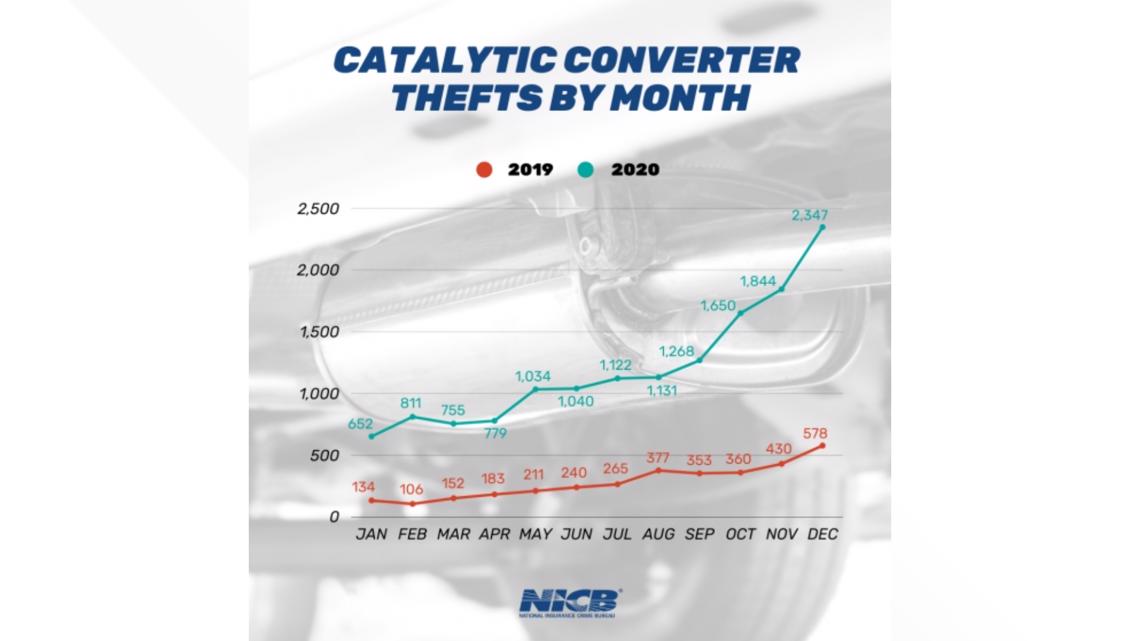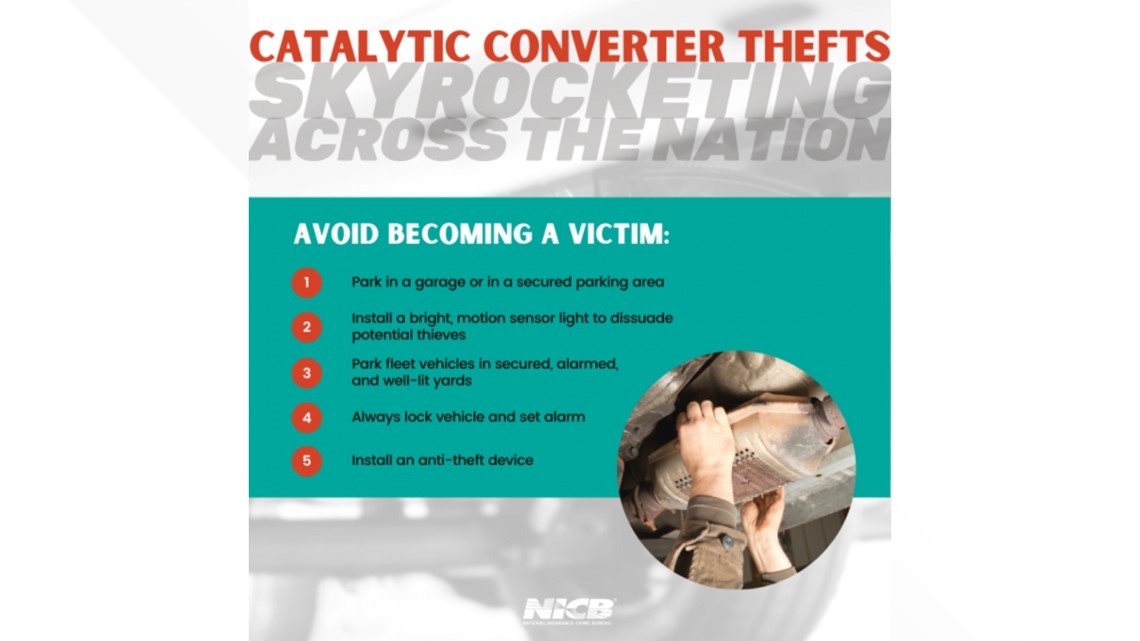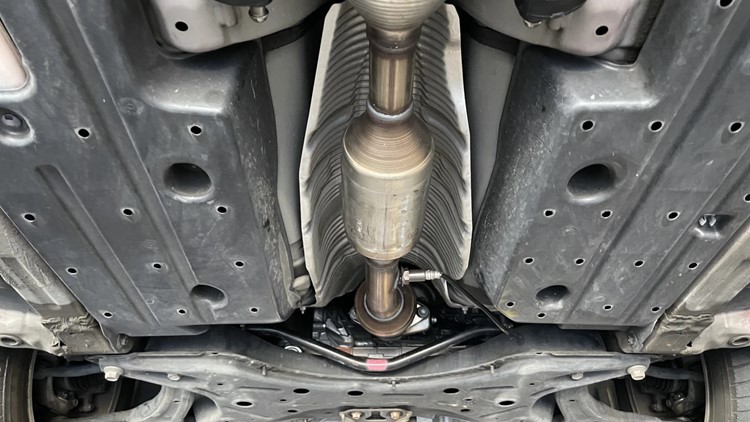SAN DIEGO — In early July 2021, Kate Glenn, a Rancho Peñasquitos resident, received a text message from her neighbor two doors down. He warned that the catalytic converter on his car had been stolen in the middle of the night.
At first, Glenn wasn’t sure what this meant. “I’m not a car person, you know, I just drive them,” Glenn said. She asked her neighbor if every car had a catalytic converter, to which he answered affirmatively. “That really made me feel vulnerable,” Glenn said.
Glenn started doing her own research and quickly found that catalytic converter theft is a widespread and growing issue. A surge in catalytic converter thefts has been sweeping through San Diego County in recent months.
Catalytic converters are located on the underside of a vehicle as part of the exhaust system. They look like small mufflers and are used to clean harmful gasses from a car’s exhaust emissions.
But what makes catalytic converters a target for thieves are the precious metals contained within: platinum, rhodium and palladium.
According to a March 2021 National Insurance Crime Bureau analysis, the value of these metals has greatly increased during the pandemic.
“It's an opportunistic crime,” said David Glawe, president and CEO of the bureau, in a public statement.
“As the value of the precious metals contained within the catalytic converters continues to increase, so do the number of thefts of these devices. There is a clear connection between times of crisis, limited resources, and disruption of the supply chain that drives investors towards these precious metals,” Glawe said.
The bureau estimates that at the end of 2020, rhodium was valued at $14,500 per ounce, palladium at $2,336 per ounce, and platinum going for $1,061 per ounce. Recyclers will typically pay between $50 and $250 per catalytic converter.


A critical impact
When Glenn opened up a dialogue regarding catalytic converter thefts on Facebook and the Nextdoor app, she was surprised by the responses she received.
“So many people chimed in,” Glenn said. “‘We were hit,’ ‘my neighbors were hit,’ ‘we’ve had to buy a new car.’” Glenn began to feel that what was such a widespread issue was not being taken seriously enough.
When catalytic converters are stolen from a vehicle, that vehicle should not be driven. It will still operate, mechanics say, but not optimally for vehicle lifespan and safety. Victims of theft can be left without a fully functioning automobile for what has the potential to become a lengthy period of time.
“This has a critical impact on our economy, from my perspective,” Glenn said. “You need transportation to go to work. You’ve been immobilized from an auto theft and it’s not a bigger issue? Why not? Why isn’t it?”
Police work to curb thefts
As of late November 2021, the San Diego County Sheriff’s department had received 461 catalytic converter theft reports since January 2021. According to Lt. Amber Baggs, the department is conducting high visibility patrols to deter thieves and utilizing investigative tools to track culprits.
The San Diego city police department saw an even larger number of catalytic converter thefts during 2021. They had roughly 1,300 reports and have been encouraging residents to park in well-lit areas.
Lt. Bode Berreth of the Escondido Police Department said their officers are committed to cracking down on this regional issue.
Thieves typically steal the converters at night by sliding under a vehicle and removing the converter with a saw. Generally those whose vehicles have been targeted won’t realize that there has been a theft until they get into their car in the morning, turn it on, and hear a loud noise.
For a car part that is easy to steal, replacing it is a difficult task and leaves a hefty dent in the pockets of victims.
“To replace a catalytic converter it can be around $1,500… A lot of cars now have more than one. So it adds up very quickly on the cost,” Berreth said.


According to Berreth, the Toyota Prius is being targeted more frequently than other car models because they are designed with multiple catalytic converters.
Berreth says Escondido nighttime patrol officers are being given increased training and education on how to identify a catalytic converter in the event that they pull someone over in possession of the car part.
In the past, when officers pulled over a suspect with a catalytic converter in their car and had the suspicion it was stolen, they haven’t been able to make an arrest unless there was a victim linked to the crime. But according to Berreth, that is changing.
Berreth said that the district attorney’s office is now willing to file for possession of stolen property simply if someone is driving at night with a catalytic converter in their car.
“Just because there’s no other reason to have it other than it was stolen,” Berreth said. “Which is a step forward for us… this allows officers to make an arrest versus let them go, and then dig up cases and try to reverse engineer.”
Berreth calls this change a step in the right direction for cracking down on thefts.
Lt. Randy Soulard of the El Cajon Police Department said in a statement to inewsource that their officers are also aware of this growing issue. “There is a significant increase in the theft of catalytic converters in our area,” Soulard said. “Officers are on the lookout for these crimes, which occur very quickly.”
How to avoid becoming a target
Jodee Reyes, public information officer for the Carlsbad Police Department, said that between October 2021 and December 2021 they saw 46 catalytic converter thefts. The top three targeted vehicles there have been the Toyota Prius, Honda Element and the Honda Accord.
The Carlsbad Police Department is conducting patrols in areas where vehicles are most commonly targeted. They are also collaborating with the entire county to discuss trends and identify suspects.
Reyes said increased education is being used to address this trend. Members of their Senior Volunteer Patrol have been personally delivering educational materials to neighborhoods where catalytic converters have been stolen.
There are a few ways that residents can avoid a catalytic converter theft, according to Reyes. Car-owners should consult their mechanic about installing cat shields, cat clamps or cat locks, devices specifically designed to deter catalytic converter theft.
Reyes said residents should consider installing a motion sensor light that points toward their vehicle and lights up when someone approaches.
They should also report any suspicious noises. “We have caught catalytic converter thieves when alert neighbors hear a noise during the night and take quick action to call the police,” Reyes said.
A call for action
Some changes have been made at the legislative level, including SB 366, authored by State Sen. Tom Umberg and signed into law in October 2021.
SB 366 requires the Department of Motor Vehicles to investigate unlicensed and unpermitted auto dismantlers and the growing issue of catalytic converter theft.
In a statement to inewsource, State Senator Toni Atkins’ office said they received two emails and one phone call regarding catalytic converter thefts in 2021.
San Diego residents like Kate Glenn are eager to draw more attention to the issue.
“I’m ready to take it to city hall. You know, we’re building back better. How in the world can you, when we’re cut off at our ankles?” Glenn said. “We can’t build back better if we can’t get on the road to get to work … This is a public safety issue.”
inewsource is a nonprofit, independently funded newsroom that produces impactful investigative and accountability journalism in San Diego County. Learn more at inewsource.org.



